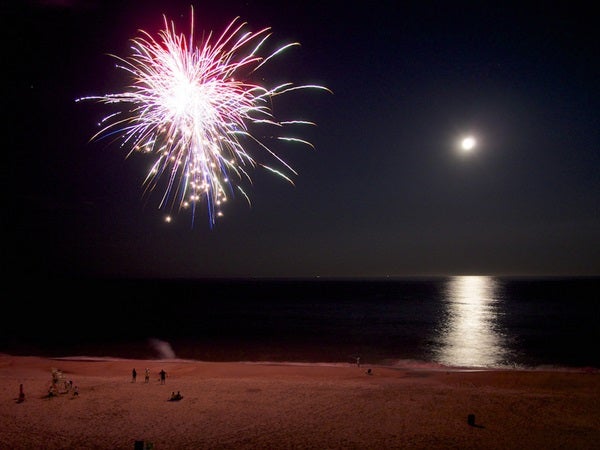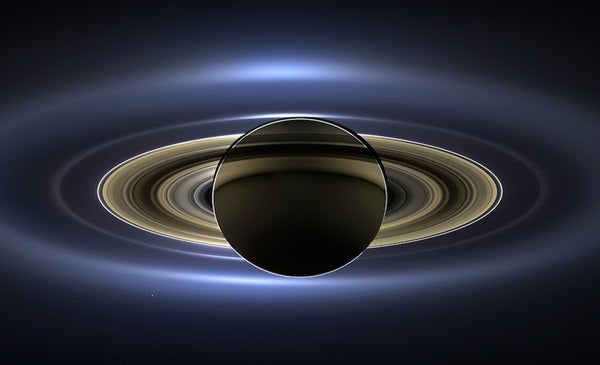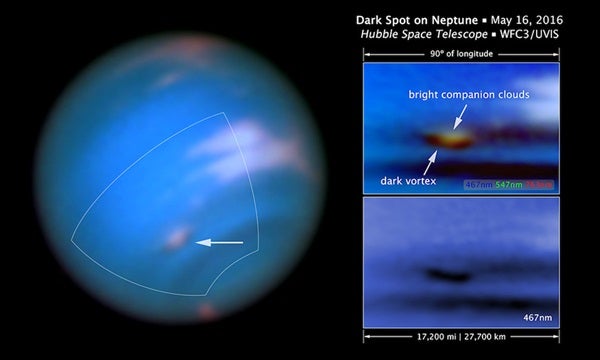Friday, June 29
Venus dominates the western sky after sunset. The dazzling object shines at magnitude –4.1 among the background stars of western Leo, having crossed the border from Cancer earlier in the day. The planet appears 15° high an hour after sundown and sets around 11 p.m. local daylight time. When viewed through a telescope, Venus appears 16″ across and 70 percent lit.
The Moon reaches apogee, the farthest point in its orbit around Earth, at 10:43 p.m. EDT. It then lies 252,315 miles (406,061 kilometers) from Earth’s center.
Saturday, June 30
Mars remains a stunning sight all week. It rises a little before 11 p.m. local daylight time and climbs nearly 30° high in the south by the time morning twilight commences. Although the Red Planet is still a month away from its late July opposition, it appears noticeably brighter than it did just a week ago. Shining at magnitude –2.2, it rivals Jupiter as the second-brightest point of light in the night sky after Venus. Tonight, however, it appears a little less brilliant because it tracks across the sky with a waning gibbous Moon. The two remain within about 5° of each other all night. If you point a telescope toward Mars, you’ll see its 21″-diameter disk and perhaps some subtle surface features — though many of these may be obscured by the planet’s major ongoing dust storm.
For people who live near 30° north latitude, today marks the latest sunset of the year. Although Earth’s summer solstice and the Northern Hemisphere’s longest day occurred more than a week ago (on the 21st), latest sunset happens several days after and earliest sunrise several days before. The specific dates depend on your latitude, however — latest sunset at 40° north took place June 27. In general, latest sunset occurs closer to the solstice the farther north you live.
Sunday, July 1
Magnificent Saturn reached its peak last week, when it appeared opposite the Sun in the sky, and our view of the ringed planet remains spectacular. It is on display nearly all night among the background stars of northern Sagittarius, hanging in the southeastern sky as darkness falls and climbing high in the south by midnight local daylight time. Saturn continues to shine brightly, too, at magnitude 0.0. When viewed through binoculars, you’ll find the Trifid Nebula (M20) 4.7° to the west, with the even brighter Lagoon Nebula (M8) 1° south of the Trifid. Open cluster M25 resides 4.0° northeast of the planet and globular cluster M22 is 3.5° southeast of the ringed world. But the best views of Saturn come through a telescope, which reveals the planet’s 18″-diameter disk surrounded by a dramatic ring system that spans 42″ and tilts 26° to our line of sight.
Monday, July 2
Skygazers can catch a peek of Mercury in this week’s early evening sky. The innermost planet stands 10° high in the west-northwest a half-hour after sunset. Although Mercury glows brightly this evening, at magnitude 0.0, you might need binoculars to spot it initially against the twilight glow. Through a telescope, Mercury shows a disk that spans 6.8″ and appears slightly more than half-lit.
Tuesday, July 3
If ever there was a good time to track down Pluto, this is the night. The distant world appears a mere 3.5″ west of the 6th-magnitude star 50 Sagittarii in northeastern Sagittarius, making the task of finding the dwarf planet much easier than usual. Pluto glows dimly at 14th magnitude, however, so you’ll need an 8-inch or larger telescope to spot it visually.
Wednesday, July 4
No holiday better epitomizes summer in the United States than Independence Day. And the season’s namesake asterism — the Summer Triangle — will be on prominent display as fireworks ring out across the land. The trio’s brightest member, Vega in the constellation Lyra the Harp, stands nearly overhead in late evening. The asterism’s second-brightest star, Altair in Aquila the Eagle, then lies about halfway from the southeastern horizon to the zenith. Deneb, the luminary of Cygnus the Swan, marks the Summer Triangle’s third corner. Although it is this asterism’s dimmest star, it’s the brightest point of light in the northeastern sky.
Thursday, July 5
Neptune rises around midnight local daylight time and appears nearly halfway from the southeastern horizon to the zenith as morning twilight commences. The magnitude 7.9 planet lies in Aquarius, 1.0° west-southwest of 4th-magnitude Phi (f) Aquarii. You can confirm your sighting of Neptune through a telescope, which reveals the planet’s 2.3″-diameter disk and blue-gray color.
Friday, July 6
Last Quarter Moon arrives at 3:51 a.m. EDT. It rises in the east around 1 a.m. local daylight time and climbs higher in the southeast as dawn approaches. During this period, our half-lit satellite lies among the background stars of northern Cetus the Whale.
If you ever thought the Sun’s distance controlled temperatures here on Earth, today should convince you otherwise. Earth reaches its most distant point from the Sun at 1 p.m. EDT. At this so-called aphelion, the two lie 94.5 million miles (152.1 million kilometers) apart, some 3.1 million miles (5.0 million km) farther away than they were at perihelion in early January. The Northern Hemisphere’s warm temperatures at this time of year arise because the Sun passes nearly overhead at noon; during winter, the Sun hangs low in the sky.
Saturday, July 7
Observers of the outer solar system can get a good view of Uranus before dawn. The best time to look for it is shortly before twilight begins around 3:30 a.m. local daylight time. Uranus then lies 25° above the eastern horizon among the background stars of southwestern Aries the Ram. This morning, use binoculars to find the magnitude 5.8 planet 4.3° northeast of the 4th-magnitude star Omicron (o) Piscium. A telescope reveals Uranus’ blue-green disk, which spans 3.5″.
Sunday, July 8
Although Jupiter reached opposition and peak visibility two months ago, it remains a stunning sight from evening twilight until it sets around 2 a.m. local daylight time. Jupiter shines at magnitude –2.3 and is essentially tied with Mars as the night sky’s brightest point of light once Venus sets by 11 p.m. The gas giant resides among the background stars of Libra the Scales, 2.1° northwest of Zubenelgenubi (Alpha [a] Librae). If you view the planet through a telescope tonight, its disk spans 41″ and displays spectacular cloud-top detail.












